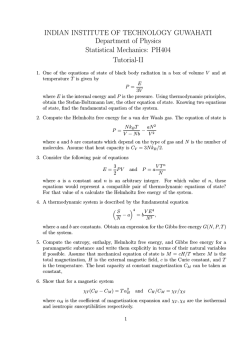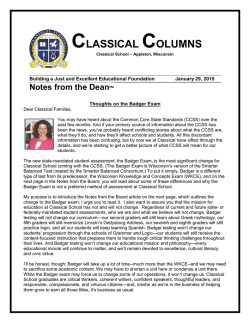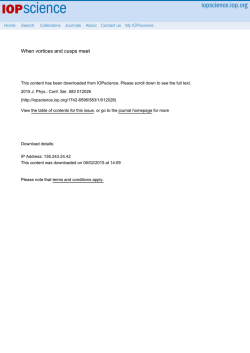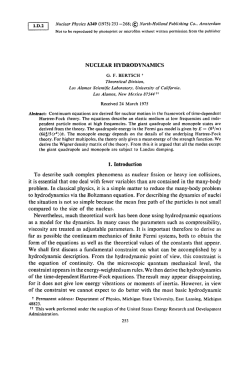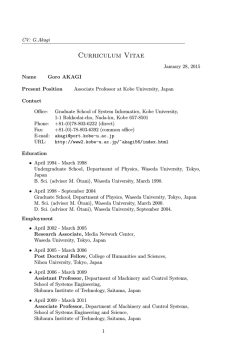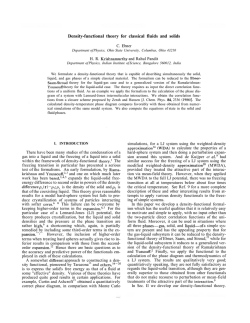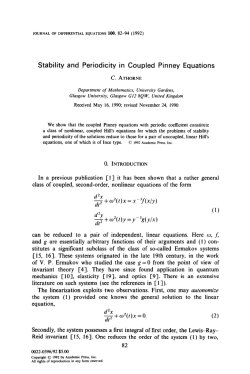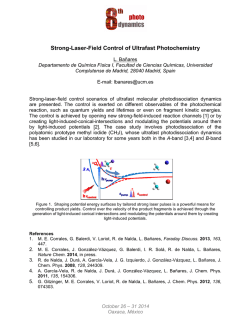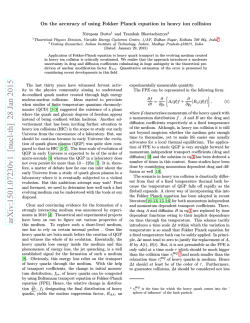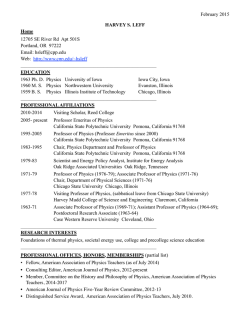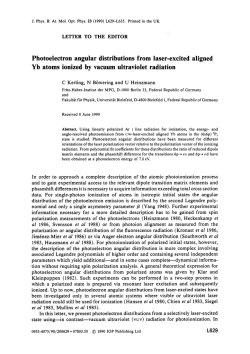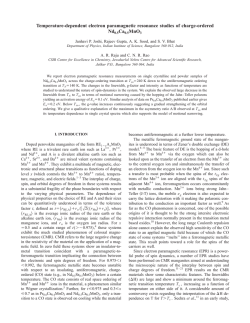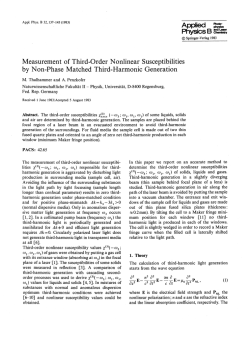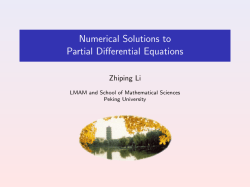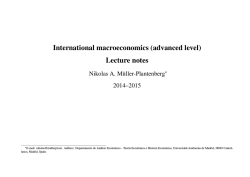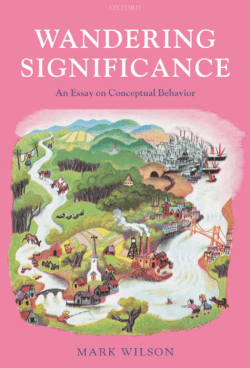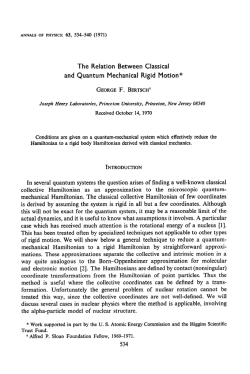
CNLS-97-01 Classical integrability of chiral QCD 2 and classical
CNLS-97-01 Classical integrability of chiral QCD2 and classical curves. Robert de Mello Koch and Jo˜ ao P. Rodrigues, Department of Physics and Centre for Non Linear Studies, University of the Witwatersrand, Wits 2050, South Africa In this letter, classical chiral QCD2 is studied in the lightcone gauge A− = 0. The once integrated equation of motion for the current is shown to be of the Lax form, which demonstrates an infinite number of conserved quantities. Specializing to gauge group SU (2), we show that solutions to the classical equations of motion can be identified with a very large class of curves. We demonstrate this correspondence explicitly for two solutions. The classical fermionic fields associated with these currents are then obtained. 1) In the early seventies, a number of 1+1 dimensional field theories were shown to be integrable [1]. It was soon realized that the S matrices of these theories could be computed exactly [2] as well as the eigenfunctions and spectrum of the Hamiltonian [3]. There have been recent claims using non-abelian bosonization that two dimensional QCD with massless quarks in the fundamental representation is integrable [4]. There are a certain number of properties usually associated with integrable two dimensional field theories: their classical equations of motion can be recast as a Lax form, from which the existence of an infinite number of conservation laws can be established, and if these survive quantization they in turn ultimately imply an elastic S- matrix with no particle production. These theories are also usually associated with the existence of a large number of soliton- like solutions of the classical equations of motion. The specific way in which the form of QCD2 integrability might be reconciled with the considerable existing evidence of particle production [5], [6] in the large Nc expansion of QCD2 [7] remains to be explained. 1,2 In this letter, we investigate the existence of exact solutions to the classical equations of motion of chiral QCD2 in the gauge A− = 0 and in light cone coordinates. We start by obtaining the classical equations of motion for colored SU (N ) currents and recast them in a Lax form . Specializing to SU (2), we show that solutions to these equations of motion can be identified with a very large class of curves described by Frenet-Serret equations. They are also invariant under a continuos symmetry. We briefly describe two particular solutions, one of which can be made to acquire the quantum numbers of a baryon. We then proceed to obtain the classical fermion fields associated with these currents. Although the relevance of classical solutions for fermionic theories might not be obvious, they have been used in the past by Papanicolaou [9], to obtain equal time large N bilocals. We implement a similar construction using color for ’tHooft’s solution. 2) We work in lightcone co-ordinates 3 and in the axial gauge A− = 0. For quarks ψa = [ψ−a , ψ+a ]T in the fundamental representation of SU (N ) (a = 1, 2, ...N ), the Lagrangian density is given by √ √ 1 T r(∂− A+ )2 + i 2ψ+a † ∂− ψ+a + 2ψ−a † (iδab ∂+ + gA+ab )ψ−b 2 † † −m(ψ−a ψ+a + ψ+a ψ−a ). L= (1) With x+ as ”time”, the fields A+ and ψ+ are not dynamical. Solving their constraint equations, we let ψ−a → ψa , m → 0 and obtain (x = (x+ , x− )): Z √ g2 † L= i 2ψa (x)∂+ ψa (x) + dy − × 2 Z g2 ×ψa † (x)ψb (x)|x− − y − |ψb † (x+ , y − )ψa (x+ , y − ) − dy − × 2N ×ψa † (x)ψa (x)|x− − y − |ψb † (x+ , y − )ψb (x+ , y − ). 1 (2) There are 1+1 string theories with infinite dimensional symmetries and particle production [8], but this results from momentum non-conservation. 2 For a recent attempt to reconcile these distinct aspects of QCD2 , see reference [17]. 3 Our conventions are x± = √12 (x0 ± x1 ) = x∓ and γ 0 = σ1 , γ 1 = iσ2 1 It is known that the m = 0 limit is singular in two dimensions. This is, however, the limit considered in [4] and in any case we will restrict ourselves in this paper mainly to classical considerations. The classical equation of motion can be written as g2 i∂+ ψa (x) = √ σab (x)ψb (x) 2 where the potential σab is given by Z 1 σab (x) = dy − |x− − y − | ψa (x+ , y − )ψb† (x+ , y − ) − δab ψc (x+ , y − )ψc† (x+ , y − ) . N (3) (4) The currents are related to the potential by 1 2 ∂− σab (x) = 2 ψa (x)ψb† (x) − δab ψc (x)ψc† (x) , N (5) and it follows from (3) that they satisfy ig 2 2 2 ∂+ ∂− σ = √ [∂− σ, σ]. 2 (6) Equation (6) is after all the classical covariant conservation equation for the SU (N ) currents with an ”external” gauge potential expressed via Gauss’ Law in terms of the fermionic currents themselves. From this point of view, the presence of the commutator on the right hand side of (6) is entirely natural. However, interpreting x+ as time, equation (6) takes the form of an (ultra- local) Lax pair. It is also a total x− derivative, an observation that forms the basis of the analysis of [4]. 4 To obtain the time dependence of ∂− σab , we write (using (4) - (6)) Z 1 i∂+ ∂− σab (x)= i∂+ dy − (x− − y − ) ψa (x+ , y − )ψb† (x+ , y − ) − δab ψc (x+ , y − )ψc† (x+ , y − ) N Z ig 2 2 = √ dy − (x− − y − )[σ, ∂− σ]ab . (7) 2 2 2 Noticing that ∂− [∂− σ(x), σ(x)] = [∂− σ(x), σ(x)], one can integrate by parts, and provided the boundary term vanishes, one obtains g2 i∂+ ∂− σab (x) = √ [σ(x), ∂− σ(x)]ab . 2 (8) This equation is the integrated version of equation (6), and the above argument explains the precise conditions under which it indeed follows from equation (6). Both equations (6) and (8) are of the Lax form and highly unusual for a two dimensional system. They imply that ∂+ T r(∂− σ(x))n = 0; 2 ∂+ T r(∂− σ(x))n = 0 (9) for every ”space” point x− , generating an infinite number of conserved charges. One should notice that ∂− σ depends nonlocally on the quark fields. Nonlocal conservation laws have been discussed in [10]. Due to the fact that one is dealing with a gauge theory, one might be concerned that some of the properties described above are artifacts of the gauge choice. An example has been discussed in [18]. However, certainly the infinite set of local conserved quantities in (9) are gauge invariant. 3) We observe that the equations of motion (6) and (8) are invariant under the continuos symmetry x− → f (x− ). This is unexpected since the action does not have such a symmetry (we will describe later how this symmetry is 4 The equation considered in [4] has an extra term associated with the chiral anomaly, resulting from integrating out the fermionic fields as part of the sequence of change of variables used in the approach. 2 implemented at the level of the classical fermion fields) 5 . This situation where the equations of motion have more symmetry than the action from which they are derived is somewhat unique. From now on, we specialize to SU (2) and write σab (x) = 1 i i f (x)σab 2 (10) where the σi are the standard Pauli matrices. Equation (8) becomes g2 ∂+ ∂− f i = √ ijk ∂− f j f k . 2 (11) Since from (9) ∂− f i ∂− f i is ”time” independent, we use the x− diffeomorphism invariance of (11) to move to an arclength co-ordinate 6 s for which ∂s f i ∂s f i = 1. We note the similarity between the equations of motion g2 ∂+ ∂s f i = √ ijk ∂s f j f k , 2 ∂s f i ∂s f i = 1 (12) and those of the continuos Heisenberg spin chain [10] ∂t S i = ijk S j ∂x2 S k , S i S i = s(s + 1). (13) The normal, binormal and osculating normal respectively ei1 = ∂s f i , ei2 = 1 2 i ∂ f , κ s ei3 = 1 ijk ∂s f j ∂s2 f k , κ (14) (with the curvature given by κ2 = ∂s2 f i ∂s2 f i ) satisfy, using (12), g2 ∂+ ei1 = √ ijk f j ek1 , 2 1 g2 ∂+ ei2 = − (∂+ κ)ei2 + √ ijk f j ek2 κ 2 2 1 g ∂+ ei3 = − (∂+ κ)ei3 + √ ijk f j ek3 . κ 2 (15) They are also known to satisfy the Frenet-Serret equations ∂s ei1 = κei2 ∂s ei2 = τ ei3 − κei1 ∂s ei3 = −τ ei2 . (16) i j k with the torsion τ defined as κ2 τ = ijk f,s f,ss f,sss . Requiring (15) and (16) to be compatible we immediatly obtain ∂+ κ = 0, ∂+ τ = √ 2 2g , g2 ∂+ (en )i = √ ijk f j ekn , 2 (17) 2 g i.e. κ = f (x− ), τ = √ x+ + h(x− ), with f, g arbitrary. Therefore, all curves with a torsion rising linearly in 2 ”time” x+ (corresponding to a constant contribution to the torsion at an equal ”time” slice) are solutions of (12). Conversely, this very large class of curves is equivalently described by equation (12). It is known that for a given torsion and curvature a classical curve is specified by a solution to the Ricatti equation [11]. Its equivalent description via equation (12) indicates that it may be possible in some cases to use inverse scattering methods on equation (12) to obtain solutions of the Ricatti equation. The connection between solitons and curves has been discussed by a number of authors [12]. In particular, Lamb [13] in connection with the Sine-Gordon equation, has described a curve of curvature κ = 2asech(as) and torsion τ = g2 + constant. This curve upon identifying τ = √ x provides a soliton solution of (3.2). Explicitly 2 As an example, it is easy to see from (4) that under ψ → ψ 0 (x) = a1 ψ(x+ , ax− ), σ 0 (x) = σ(x+ , ax− ) and that this transformation can not be a symmetry of the action since it does not respect the conformal (scale) weight of the fermion field. 6 This is in the manifold of the Lie algebra of course. 5 3 f 1= −2a g4 2 f 2= g2 sech(as)sin( √ x+ s) 2 x+2 + a2 g2 sech(as)cos( √ x+ s) 2 + a2 2a g4 +2 2 x f 3= s − 2a g4 +2 2 x + a2 tanh(as). (18) In a separate communication, we will show that this is the reflectionless single bound state eigenvalue solution to the Gelfand-Levitan- Marchenko equation, arising in a systematic inverse scattering treatment of chiral QCD2 . g2 + We also state the solutions with constant curvature κ and τ = √ x : 2 r g 4 x+2 f = g 4 x2 s) sin( κ2 + 2 + 2 + κ 2 r κ g 4 x+2 2 cos( κ2 + f = g 4 x2 s) 2 + + κ2 κ 1 2 g 2 x+ s f 3= − √ q . 4 +2 2 κ2 + g x2 (19) 4) Provided the fermion fields are treated classically, as we will do in the following, it follows from equation (5) for the SU (2) case that 2 ∂− σab ψb = (ψc ψc† )ψa ≡ λψa . (20) The fermion number density λ is easily seen to be related to the curvature κ by κ = 2λ, and is therefore x+ independent. Equation (20) determines ψa up to a phase, which we now show can always be chosen so that (3) is satisfied: differentiating equation (20) with respect to x+ and using equation (6), we readily obtain (in matrix notation) g2 g2 2 ∂− σ(i∂+ − √ σ)ψ = λ(i∂+ − √ σ)ψ 2 2 (21) from which it follows from (20) that g2 (i∂+ − √ σ)ψ = (∂+ φ)ψ. 2 (22) So, if ψ satisfies (20) and φ (22), then ψ˜ = eiφ ψ will satisfy (3). We can write − eiϕ(x ) eiφ ψ= q 2 f3 2 2λ + ∂− 2 3 2λ + ∂− f 2 1 2 2 ∂− f + i∂− f (23) where ϕ(x− ) is arbitrary and, 2 i f + 2λf 3 g 2 f i ∂− ∂+ φ = − √ . 2 f3 2λ + ∂− 2 2 (24) It is not difficult to obtain an action in terms of fi , i = 1, 2, 3 and φ which yields equations of motion equivalent to (6) and (24). It is not significantly different from the action introduced in [10] to treat spin degrees of freedom. Then, the continuos symmetry referred to above is not apparent, and one might consider fixing it at the classical level. It is not clear to us that this should be the correct approach, although this issue clearly deserves further study beyond the scope of this communication. We limit ourselves to presenting classical solutions with properties which are physically acceptable. We do this in the next section. 4 5) One way in which our soliton solution (18) can be made to aquire the properties expected of a SU (2) baryon, is to consider the reparametrization ∂− s = sech2 (as) (25) i.e. f i = f i (s(x− )); 2 i 2 i i ∂− f = (∂− s)f,s + (∂− s)2 f,ss (26) Although the expressions (26) are rather involved and will not be displayed in this communication, we note that Z Z Z Z ∞ q q dx− ds − † − − 2 2 2 s)2 = 2. i i ∂− f ∂− f = (∂− s)4 κ2 (s) + (∂− (27) dx ψa ψa = dx λ(x ) = 2 −∞ 2∂− s Due to the improved behaviour at x− → ±∞, the SU (N ) color charges vanish and Z Z Z g2 g2 g2 g2 2 P+ = − dx− T r(∂− dx− T r(∂− σ)2 = dx− (∂− s)2 = (28) σ)σ = 4 4 8 4a R We have verified that P − = i dx− ψa† ∂− ψa = 0. This is a non-trivial calculation, requiring detailed knowledge of the solution (23)- (26). 6) We now illustrate how ’tHooft’s solution to the large N gap equation can be constructed from one of our classical SU (2) solutions. A related analysis has been carried out by Papanicoloau [9] for the classical solutions of the O(2) Gross-Neveu model [14]. Papanicoloau obtains a system of pseudospin constraints for fermionic systems with O(N ) symmetry and he describes how to construct equal time correlators which satisfy the large N limit of these constraints as well as the theory’s Heisenberg equations of motion from finite N solutions to the classical equations of motion. QCD2 is of course U (NC ) symmetric but more importantly, we will consider unequal time correlators 7 . In other words, we are able to construct the ”masterfield” for unequal time correlators from solutions to the classical equations of motion. √ If one denotes the standard U (N ) invariant ”time” ordered two point by G(x; y) and rescales as usual ψa → N ψa , 2 g 2 → gN , one obtains in the large N limit the standard gap equation Z √ x G(x; y) + g 2 dw− G(x+ , x− ; x+ , w− )|x− − w− |G(x+ , w− ; y + , y − ) = iδ(x− − y − ). (29) i 2∂+ Integrating both sides of (29) with respect to x+ infinitesimally around y + , we obtain h √ i 2 lim→0 G(x− , y + + ; y − , y + ) − G(x− , y + − ; y − , y + )] = iδ(x− − y − ). (30) In a perturbative second quantized formalism, (30) is an anticommutation relation. We consider now the solutions of constant curvature (19) with κ = 2k− . In the terminology of our previous section, ’tHooft’s meson background corresponds to ”static” (x+ independent) solutions. It is a peculiarity of QCD2 in the chiral limit and in light cone quantization that the static solutions of the equations of motion (3) are also their g 2 → 0 limit. From equations (19) and (23) it then follows that r − κ ϕ1k− eik− x eiπ/2 = . (31) − ϕ2k− 2 e−ik− x e−iπ/2 The relativistic bilocal field is constructed from a superposition of these solutions as 8 Z ∞ + + dk− G(x, y) = θ(x+ − y + ) f+ (k− )e−iωk− (x −y ) ϕ1k− (x− )ϕ∗1k− (y − ) 2π Z0 ∞ + + dk− + + f− (k− )eiωk− (x −y ) ϕ2k− (x− )ϕ∗2k− (y − ). −θ(y − x ) 2π 0 7 (32) Reference [15] discusses U (N) symmetric theories in an equal time formalism. The need for halving the number of color degrees of freedom in order to satisfy Papanicoloau’s pseudo spin constraints in an equal ”time” treatment of QCD2 has been anticipated by A.Jevicki [16]. 8 5 The functions f± are chosen so that (30) is satisfied. A simple choice is √ 2 f+ (k− ) = f− (k− ) = . k− It is now straight forward to substitute (32)-(33) in the gap equation (29) which is satisfied provided Z 0 0 dk− (k− + k− ) g2 ωk− = , 02 2 2π k− (33) (34) which is the familiar (tachyonic) zero quark mass limit of ’tHooft’s background dispersion [7]. We remark that if + one was to regard ’tHooft’s large Nc bilinears G(x, y) as built form the ”time” dependant ansatz ϕ(x− )e−iωk x , then these do not satisfy the classical equations of motion in agreement with conclusions presented in [17]. Acknowledgements RdMK would like to thank the members of the Brown High Energy Physics group, where part of this work was done, for their hospitality. [1] [2] [3] [4] [5] [6] [7] [8] [9] [10] [11] [12] [13] [14] [15] [16] [17] [18] H.B. Thacker, Rev. Mod. Phys. 53 (1981) 253. A.Zamolodchikov and A.Zamolodchikov, Ann. Phys. 120 (1979) 253. N. Andrei, K. Furuya and J.H. Lowenstein, Rev. Mod. Phys. 55 (1983) 331. E. Abdalla and M.C.B. Abdalla, Phys. Lett B337 (1994) 347; E. Abdalla and M.C. Abdalla, Int. Jour. Mod. Phys. A10, (1995) 1611; E. Abdalla, Towards a solution of two-dimensional QCD, hep-th 9510139 to be published in the proceedings of ICTP workshop on Strings, Gravity and Related Topics, Trieste, Italy, 29-30 June 1995; E. Abdalla and M.C.B. Abdalla, Phys. Rev. D52 (1995) 6660; E. Abdalla and M.C.B. Abdalla, Phys. Rep. 265 (1996) 253. C.G.Callan, N.Coote and D.J.Gross, Phys. Rev. D13 (1976) 1649. W.Krauth and M.Staudacher, Phys. Lett. B388, (1996) 808. G. t’Hooft, Nucl. Phys. B75 (1974) 461. J. Polchinski, Nucl. Phys. 362, (1991) 125; K.Demeterfi, A.Jevicki and J.P.Rodrigues, Mod. Phys. Lett. A6 (1991) 3199. N. Papanicoloau, Ann. Phys. 136 (1981) 210. A.Jevicki and N.Papanicoloau, Ann. Phy. 120, (1979) 107. L.P. Eisenhart, A Treatise on the Differential Geometry of Curves and Surfaces, (Dover, New York, 1960) Sec. 13-15. H. Hasimoto, J. Fluid Mech. 51, (1972) 477. G.L. Lamb, Jour. Mth. Phys. 18, (1977) 1654. A. Neveu and N. Papanicoloau, Commun. Math. Phys. 58 (1978) 31. A. Dhar, G. Mandal and S.R. Wadia, Nucl. Phys. B436 (1995) 487. A. Jevicki, private communication. E. Abdalla and R. Mohayaee, hep-th 9610059. Y.Frishman, A.Hanany and J.Sonnenschien, Nucl. Phys. B429 (1994) 75. 6
© Copyright 2025
